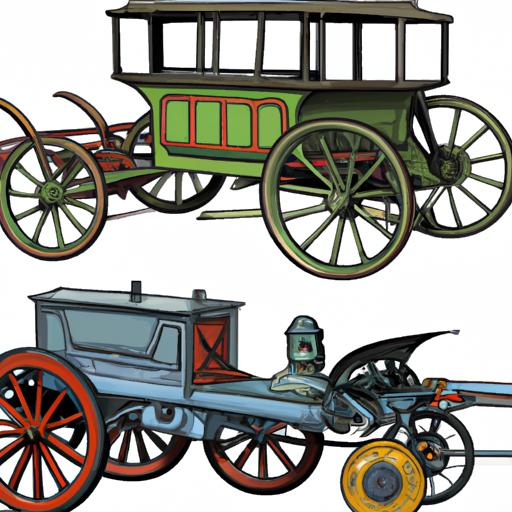Have you ever wondered how the marvel of modern transportation, the car, came into existence? The evolution of automobiles is truly an intriguing tale that has transformed the way we travel and connect with the world. In this article, we will delve into the captivating history of car invention and highlight the significance of understanding its origins.
A Brief Overview of the History of Automobiles
Since time immemorial, humans have sought means to make their journeys easier and more efficient. From the invention of the wheel to the development of various modes of transportation, the path towards the creation of cars spans centuries.
Early forms of transportation relied on the power of animals or human strength. However, the true revolution began with the birth of steam-powered vehicles. In the late 18th century, the ingenious mind of Nicolas-Joseph Cugnot brought forth the first self-propelled steam car, laying the foundation for future automotive advancements.
Importance of Understanding How Cars Were Invented
To truly appreciate the significance and impact of automobiles in our lives, it is essential to comprehend their historical roots. Exploring the origins of car invention not only enriches our knowledge but also deepens our understanding of the continuous innovation driving the automotive industry.
By understanding the challenges and breakthroughs that pioneers faced during the early stages of car development, we gain insights into the engineering marvels we enjoy today. Moreover, it allows us to recognize the immense progress made in terms of speed, safety, and environmental consciousness.
Whether you are a car enthusiast, a history buff, or simply curious about the world around you, delving into the intriguing tale of how cars were invented will undoubtedly leave you captivated. So, fasten your seatbelts as we embark on an exhilarating journey through time, exploring the remarkable evolution of automobiles.
“The journey of car invention is akin to a symphony of innovation, with each note played by brilliant minds orchestrating the harmonious fusion of technology and transportation.” – Anonymous
Early Beginnings of the Automobile
A. Invention of the Wheel and Its Impact on Transportation
The invention of the wheel, one of humanity’s greatest achievements, laid the groundwork for the development of transportation as we know it. From ancient civilizations to modern times, the wheel has been a game-changer, enabling the movement of goods and people with unprecedented ease and efficiency. Without the wheel, the concept of automobiles would have remained a distant dream.
B. Development of the First Steam-Powered Vehicles
As the industrial revolution gained momentum in the 18th century, inventors began harnessing the power of steam to propel vehicles forward. The pioneering efforts of engineers like Thomas Savery and Thomas Newcomen led to the creation of steam engines, which fueled the development of steam-powered vehicles. These early contraptions were the precursors to the automobiles we see today, marking a significant leap forward in transportation technology.
C. Contributions of Nicolas-Joseph Cugnot and His Steam Car
Nicolas-Joseph Cugnot, a French engineer, is credited with building the first self-propelled steam vehicle in 1769. His three-wheeled steam car, known as the “Fardier à vapeur,” was a remarkable invention of its time. Although it had limited speed and endurance, Cugnot’s creation marked a pivotal moment in the history of automobiles. His steam car laid the foundation for future innovations, inspiring inventors and engineers to push the boundaries of transportation even further.
Cugnot’s steam car was designed to transport heavy artillery for the French army, showcasing the potential of steam power in practical applications. This invention not only revolutionized military logistics but also sparked the imagination of visionaries who foresaw a world where steam-powered vehicles would transport people and goods on a larger scale.
“The hissing steam and the clanking of gears were the symphony of progress, as Cugnot’s steam car paved the way for a future of unparalleled mobility.” – Anonymous
The Birth of Internal Combustion Engines
Introduction of the First Practical Internal Combustion Engine
In the quest for more efficient and powerful engines, the invention of the internal combustion engine marked a pivotal moment in the history of automobiles. The development of this revolutionary technology paved the way for the modern vehicles we see today.
During the early 19th century, inventors like Étienne Lenoir and Nikolaus Otto introduced the first practical internal combustion engines. These engines utilized the combustion of fuel within a confined space to generate mechanical power. This breakthrough innovation laid the foundation for a new era in automotive engineering.
Karl Benz and the Creation of the First Gasoline-Powered Automobile
One name that stands out in the annals of automotive history is Karl Benz. In 1886, Benz unveiled the world’s first gasoline-powered automobile, the Benz Patent-Motorwagen. This three-wheeled vehicle was a true engineering marvel, featuring an internal combustion engine, a chassis, and various mechanical components.
Benz’s creation not only transformed transportation but also served as a catalyst for the future of automobile design. His vision and ingenuity set the stage for the development of more sophisticated and efficient vehicles that would shape the world.
Impact of Gottlieb Daimler and Wilhelm Maybach’s Innovations
While Benz was making strides in gasoline-powered cars, another duo, Gottlieb Daimler and Wilhelm Maybach, were making their mark in the automotive industry. Daimler and Maybach were pioneers in developing high-speed internal combustion engines and lightweight vehicles.
Their innovations led to the creation of the first four-wheeled automobile powered by a gasoline engine. Their groundbreaking advancements in engine design and vehicle construction laid the groundwork for the future of automobiles, influencing generations of engineers and shaping the industry as we know it today.
The birth of internal combustion engines and the contributions of visionaries like Karl Benz, Gottlieb Daimler, and Wilhelm Maybach forever altered the course of automotive history. These inventors paved the way for a world where mobility became accessible, efficient, and exhilarating. The impact of their innovations continues to resonate in the automotive industry, fueling advancements that push the boundaries of technology and redefine the concept of transportation.
Mass Production and the Ford Model T
A Revolutionary Assembly Line System
When it comes to the mass production of automobiles, one name stands out: Henry Ford. In the early 20th century, Ford introduced a revolutionary assembly line system that transformed the manufacturing process. By breaking down the production of cars into smaller, specialized tasks, Ford’s assembly line increased efficiency and reduced costs significantly. This groundbreaking system allowed for the rapid production of vehicles, revolutionizing the automotive industry.
The Introduction of the Affordable Ford Model T
In 1908, Henry Ford unveiled the legendary Ford Model T, a vehicle that would forever change the landscape of transportation. The Model T was not only a remarkable engineering achievement but also a game-changer in terms of affordability. By implementing efficient production techniques, Ford was able to reduce the price of the Model T, making it accessible to the middle-class population.
Impact of the Model T on the Automobile Industry
The introduction of the Ford Model T had a profound impact on the automobile industry. It not only popularized car ownership but also paved the way for a new era of personal transportation. The affordability and reliability of the Model T made cars more attainable for the masses, leading to a surge in demand and subsequent growth in the automotive sector.
Moreover, the success of the Model T prompted other manufacturers to adopt Ford’s mass production methods, further revolutionizing the industry. The assembly line system became the standard for car manufacturing, enabling faster production rates and lower costs. This shift in production techniques marked a turning point in the evolution of automobiles, bringing them within reach of everyday individuals.
The Ford Model T’s impact extended beyond manufacturing and affordability. It played a significant role in shaping societal norms and transforming lifestyles. With the newfound freedom of personal transportation, people were able to explore new horizons, travel greater distances, and connect with others in ways previously unimaginable.
“The Ford Model T was not merely a car; it was a catalyst for change, propelling society into the age of mobility and transforming dreams into realities.” – Anonymous
Advancements in Car Technology
In the ever-evolving world of automobiles, advancements in technology continue to reshape the way we drive and experience transportation. From the emergence of electric cars to the integration of advanced safety features, let’s explore the remarkable innovations that have revolutionized the automotive industry.
A. Emergence of Electric Cars and Hybrid Vehicles
With the growing concern for the environment and the need for sustainable transportation, electric cars and hybrid vehicles have gained significant popularity. Electric cars run solely on electric power, emitting zero tailpipe emissions and reducing our carbon footprint. Their efficient performance and increasing range have made them a viable alternative to traditional gasoline-powered cars.
Hybrid vehicles, on the other hand, combine the benefits of both electric and internal combustion engines. By utilizing electric power for shorter distances and switching to gasoline for longer journeys, hybrids offer improved fuel efficiency and decreased reliance on fossil fuels. The development of these eco-friendly alternatives marks a major milestone in the pursuit of greener transportation.
B. Introduction of Safety Features and Advancements in Car Design
Safety has always been a paramount concern in the automotive industry. Over the years, car manufacturers have implemented various safety features to enhance driver and passenger protection. From seatbelts and airbags to anti-lock braking systems (ABS) and electronic stability control (ESC), these technologies have significantly reduced the risk of accidents and improved overall vehicle safety.
Advancements in car design have also contributed to increased safety. Crumple zones, reinforced frames, and impact-absorbing materials are meticulously engineered to absorb and distribute the force of a collision, minimizing the impact on occupants. Additionally, innovative lighting systems, such as adaptive headlights and LED technology, have improved visibility on the road, reducing the chances of accidents.
C. Influence of Computerization and Automation in Modern Vehicles
The rapid advancements in computer technology have ushered in a new era of automotive innovation. Modern vehicles are equipped with sophisticated computer systems that control various aspects of driving, from engine performance to navigation and entertainment. These systems provide seamless integration and enhance the overall driving experience.
Automation has also played a significant role in modern vehicles. From advanced driver-assistance systems (ADAS) to autonomous driving technology, cars are becoming increasingly capable of performing tasks with minimal human intervention. These advancements not only enhance convenience but also hold the promise of safer roads and reduced congestion in the future.
As technology continues to evolve, the future of car technology holds exciting possibilities. From further electrification to the integration of artificial intelligence, one thing is certain: the journey of car innovation is far from over.
“Car technology is not merely about the destination; it is a continuous voyage of exploration, where each milestone paves the way for the next horizon of possibilities.” – Anonymous
Conclusion
As we conclude our exploration of the fascinating journey of automobile invention, we are reminded of the immense impact cars have had on our lives. From humble beginnings to the modern marvels we see today, the evolution of automobiles showcases human ingenuity and our constant pursuit of innovation.
By understanding how cars were invented, we gain a deeper appreciation for the complex systems and technologies that drive our vehicles forward. From the invention of the wheel to the introduction of internal combustion engines, each milestone in car history has brought us closer to the efficient, comfortable, and eco-friendly vehicles we enjoy today.
The significance of comprehending the origins of cars goes beyond mere curiosity. It helps us recognize and acknowledge the remarkable progress made in the automotive industry. It reminds us of the challenges overcome by visionaries and engineers who dedicated their lives to transforming transportation.
Looking ahead, the future of cars holds even more exciting possibilities. With advancements in electric vehicles, autonomous driving, and sustainable technologies, we are on the cusp of a new era in automotive innovation. By understanding the past, we can better shape the future of transportation and contribute to a more sustainable world.
In conclusion, the invention of cars has revolutionized the way we travel, connect, and experience the world. It is a testament to human ingenuity, perseverance, and the relentless pursuit of progress. So, let us continue to celebrate and marvel at the wonders of automobiles, appreciating their rich history and embracing the exciting future that lies ahead.
“The invention of cars was not just about moving from point A to point B; it was about transforming dreams into reality and embarking on extraordinary journeys.” – Anonymous




